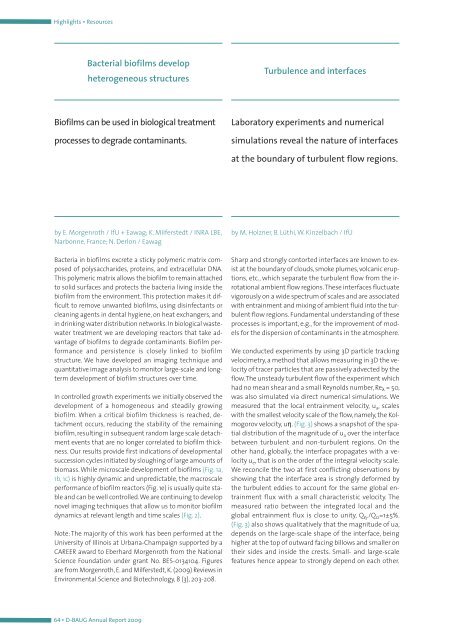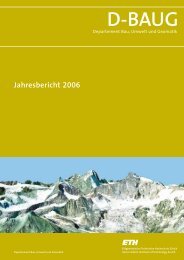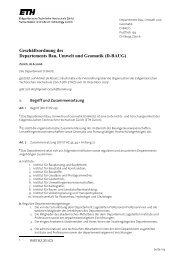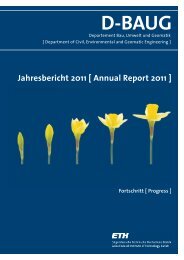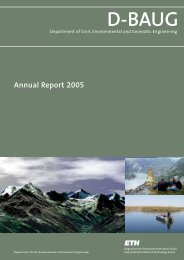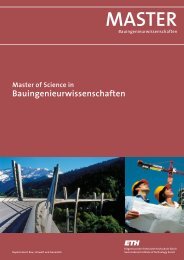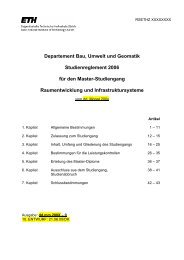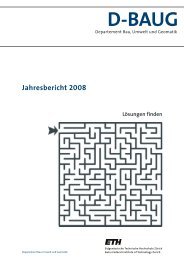D-BAUG - Departement Bau, Umwelt und Geomatik - ETH Zürich
D-BAUG - Departement Bau, Umwelt und Geomatik - ETH Zürich
D-BAUG - Departement Bau, Umwelt und Geomatik - ETH Zürich
You also want an ePaper? Increase the reach of your titles
YUMPU automatically turns print PDFs into web optimized ePapers that Google loves.
Highlights ▪ Resources<br />
Bacterial biofilms develop<br />
heterogeneous structures<br />
Biofilms can be used in biological treatment<br />
processes to degrade contaminants.<br />
by E. Morgenroth / IfU + Eawag; K. Milferstedt / INRA LBE,<br />
Narbonne, France; N. Derlon / Eawag<br />
Bacteria in biofilms excrete a sticky polymeric matrix composed<br />
of polysaccharides, proteins, and extracellular DNA.<br />
This polymeric matrix allows the biofilm to remain attached<br />
to solid surfaces and protects the bacteria living inside the<br />
biofilm from the environment. This protection makes it difficult<br />
to remove unwanted biofilms, using disinfectants or<br />
cleaning agents in dental hygiene, on heat exchangers, and<br />
in drinking water distribution networks. In biological wastewater<br />
treatment we are developing reactors that take advantage<br />
of biofilms to degrade contaminants. Biofilm performance<br />
and persistence is closely linked to biofilm<br />
structure. We have developed an imaging technique and<br />
quantitative image analysis to monitor large-scale and longterm<br />
development of biofilm structures over time.<br />
In controlled growth experiments we initially observed the<br />
development of a homogeneous and steadily growing<br />
biofilm. When a critical biofilm thickness is reached, detachment<br />
occurs, reducing the stability of the remaining<br />
biofilm, resulting in subsequent random large scale detachment<br />
events that are no longer correlated to biofilm thickness.<br />
Our results provide first indications of developmental<br />
succession cycles initiated by sloughing of large amounts of<br />
biomass. While microscale development of biofilms (Fig. 1a,<br />
1b, 1c) is highly dynamic and unpredictable, the macroscale<br />
performance of biofilm reactors (Fig. 1e) is usually quite stable<br />
and can be well controlled.We are continuing to develop<br />
novel imaging techniques that allow us to monitor biofilm<br />
dynamics at relevant length and time scales (Fig. 2).<br />
Note: The majority of this work has been performed at the<br />
University of Illinois at Urbana-Champaign supported by a<br />
CAREER award to Eberhard Morgenroth from the National<br />
Science Fo<strong>und</strong>ation <strong>und</strong>er grant No. BES-0134104. Figures<br />
are from Morgenroth, E. and Milferstedt, K. (2009) Reviews in<br />
Environmental Science and Biotechnology, 8 (3), 203-208.<br />
64 ▪ D-<strong>BAUG</strong> Annual Report 2009<br />
Turbulence and interfaces<br />
Laboratory experiments and numerical<br />
simulations reveal the nature of interfaces<br />
at the bo<strong>und</strong>ary of turbulent flow regions.<br />
by M. Holzner, B. Lüthi, W. Kinzelbach / IfU<br />
Sharp and strongly contorted interfaces are known to exist<br />
at the bo<strong>und</strong>ary of clouds, smoke plumes, volcanic eruptions,<br />
etc., which separate the turbulent flow from the irrotational<br />
ambient flow regions.These interfaces fluctuate<br />
vigorously on a wide spectrum of scales and are associated<br />
with entrainment and mixing of ambient fluid into the turbulent<br />
flow regions. F<strong>und</strong>amental <strong>und</strong>erstanding of these<br />
processes is important, e.g., for the improvement of models<br />
for the dispersion of contaminants in the atmosphere.<br />
We conducted experiments by using 3D particle tracking<br />
velocimetry, a method that allows measuring in 3D the velocity<br />
of tracer particles that are passively advected by the<br />
flow.The unsteady turbulent flow of the experiment which<br />
had no mean shear and a small Reynolds number, Re λ = 50,<br />
was also simulated via direct numerical simulations. We<br />
measured that the local entrainment velocity, u a, scales<br />
with the smallest velocity scale of the flow, namely, the Kolmogorov<br />
velocity, uη. (Fig. 3) shows a snapshot of the spatial<br />
distribution of the magnitude of u a over the interface<br />
between turbulent and non-turbulent regions. On the<br />
other hand, globally, the interface propagates with a velocity<br />
u e, that is on the order of the integral velocity scale.<br />
We reconcile the two at first conflicting observations by<br />
showing that the interface area is strongly deformed by<br />
the turbulent eddies to account for the same global entrainment<br />
flux with a small characteristic velocity. The<br />
measured ratio between the integrated local and the<br />
global entrainment flux is close to unity, Q η./Q 0=1±5%.<br />
(Fig. 3) also shows qualitatively that the magnitude of ua,<br />
depends on the large-scale shape of the interface, being<br />
higher at the top of outward facing billows and smaller on<br />
their sides and inside the crests. Small- and large-scale<br />
features hence appear to strongly depend on each other.


